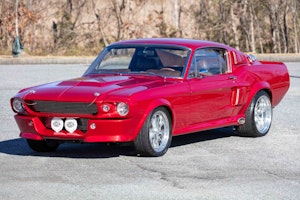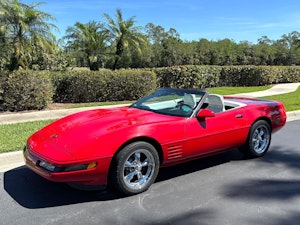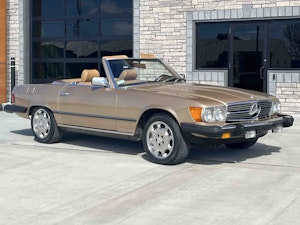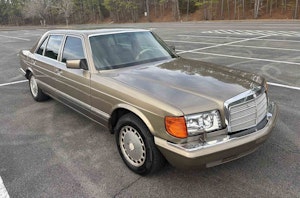Media | Articles
A brief history of the heated windshield
What’s your stance on heated windshields?
Frozen solid and armed with an ice scraper, if your car doesn’t have one. (Here all day, available for birthdays and open-mic sessions, etc.)
A heated windshield is the kind of feature you don’t know you need until Jack Frost pays a visit. Rather than arming yourself with an ice scraper or a can of de-icer, you’re able to sit in the comfort of your car while the heated glass works its magic. Your neighbors can only look on with envious eyes as ice or snow turns to water.
It’s even more miraculous if your car is of an age (or is a Caterham Seven) when ice forms on the inside of the windshield. We’ve all been there …
Charting the history of the heated windshield is trickier than clearing a layer of ice from the glass with a grocery-store rewards card. It almost certainly has its roots in the aviation history, as outlined in a journal published in 1986. In it, Lowell Bitter writes: “The history of the heated windshield begins with aircraft windshield heating in the 1940s using pyrolytic coatings. In the automotive field an unsuccessful attempt was made in the 1970s.”
Marketplace
Buy and sell classics with confidence
Bitter is referring to heated windshields fitted to the Lincoln Continental Mark IV and Ford Thunderbird. Ford’s optional Quick Defrost function could clear a windshield five times faster than conventional glass, without visible heating wires. From frost to clear view in just three minutes, which was likely faster than the 460-cubic-inch V-8 warmed up to operating temperature.

The rich and informative Automotive Mileposts website outlines the success, and failure, of Ford’s Quick Defrost system, which featured a transparent, thinly coated gold-bearing metallic film sandwiched between layers of polyvinyl butyral and glass. A second alternator fed an electric current to the film to clear the frost or ice.
It wasn’t cheap. In 1974, the Quick Defrost upgrade cost $306.70, the equivalent of $1,852.09 in 2022. At least the Mark IV owner had a distinctive gold tint to show the world that they’d splashed the cash.
Replacement screens were almost impossible to find, forcing owners into fitting conventional glass in the event of damage. “Fogging” was another issue if the Quick Defrost function wasn’t used on a regular basis, but unreliability sealed its fate, and the system was dropped.

Ford’s use of the heated windshield was put on ice, but the spark was reignited in the 1980s. Dubbed Insta-Clear in the United States and the less evocative “windshield rapid de-ice” in Europe, Ford’s new and improved heated windshield debuted on the flagship Granada Scorpio over here and in the Taurus/Sable/Continental over there.
From the Taurus brochure: “Insta-clear Heated Windshield available on Taurus models with V-6 engine, is capable of removing 1/10 of an inch of frost at 0 degrees Fahrenheit in just two to three minutes.”
Rather than a layer of film, Ford’s new system used a barely visible mesh of silver and zinc-oxide wires placed between two sheets of glass. Like a heated rear window, an electric current would heat the wires, clearing the fog, ice, or snow.
As this memorable ad shows, the screen was produced by Pilkington under the Triplex name and labeled Hotscreen. Later, Ford trademarked the Quickclear name in Europe, which is still in use today. Contrary to popular belief, Ford didn’t own a patent on the tech, just a particular application of it.

Autocar wasn’t overly impressed with the technology. In a review of the Ford Granada Scorpio 4×4, it said: “At night, the view through heated front screen initially appears slightly hazy and street lights have a distinct starburst effect on the glass because a thin heating element is sandwiched into the laminated layers. This is just visible to the eye in certain conditions but is no real distraction once the driver is accustomed to it.”
Motor agreed, labeling the heating elements “distracting at night.” Insurance companies are likely to be more distracted by the cost of replacing a heated windshield in the event of a stone chip.
Ford’s ownership of other companies, most notably Jaguar and Land Rover, means you’ll find heated windshields on many cars. It was even fitted as standard on the previous-generation Vauxhall Corsa, which is far cry from the days when it graced the Lincoln Continental Mark IV.

Interestingly, Ford has filed a patent for a heated side-window system, which could come in handy if you’re drifting a Focus RS or Mustang on a frosty morning. Related Ford patents include heated windshield camera viewing zones, heated wiper blades, steering wheel preconditioning and even a heated SecuriCode keypad. The heat is on, or something.
In the U.K., £1000 is enough to buy a used car with a heated windshield. Take your pick from dozens of Ford Focus Mk2s in Zetec Climate trim or, better still, a Focus Mk1 with a Quickclear screen—a future classic with a heated windshield for some winter fun.
Then there’s us poor sods stateside, who don’t enjoy the wonders of a heated windshield at such a low price point. Jaguar Land Rover is one of the few companies that offers it throughout their U.S. portfolio. American fans of the U.K-market Focus have hope, if they’re willing to go to much trouble; as of 2023, first-year Mk1s turn 25, qualifying them for U.S. import. —Ed.
Check out the Hagerty Media homepage so you don’t miss a single story, or better yet, bookmark it.










I recall in the 80’s some of these prevented radar detectors from working properly. That was not popular.
The Pontiac 6000 STS had this…. and several others are doing it again. It was a miserable thing too. If you are in a state with inspection stickers or have parking stickers on the inside front window…. getting them off usually destroyed it…… but it was effective. It was one of the overlooked GM Gems of the era. Sounded good. Went good…. 4 doors….
IIRC, didn’t Land Rover offer a heated windscreen on the late Series (IIa, III) trucks? Late 60’s on.
There was a run of 1967/8 “N.A.D.A.” 2a 109 station wagon Land Rovers equipped with heated windscreens. The glass had the fine horizontal wire heating elements controlled by toggle switches on the dash.
I am the Original Owner of one of the 2.6L 109 NADA’s. 717
I had a 1988 Range Rover County purchased new and it had front windshield, rear glass, as well as rear-side glass defrosting. It appeared as very small wires resembling built in radio antenna wires. It worked almost instantly!
My 2010 Land Rover LR2 had it front, back and sides. It worked brilliantly and I loved it. But after an inattentive driver hit me and totaled it I couldn’t afford a new LR. I have missed that feature (and the LR 2) ever since!
I never understood why car manufacturers didn’t just put the same electric rear window defroster on the front windshield.
Probably due to view distortion.
Also would need to be laminated into the safety glass
Replacement costs are more for the luxury. Enough now with the camera calibration, etc.
Defrost wires can’t be in the field of forward vision so that’s why they aren’t on windshields except for the few that put them at the bottom to keep the wipers from freezing. I prefer cheap plain windshields because you know you are going to eventually get a chip or crack and I do not want a $2000 windshield.
Range Rover/Land Rover vehicles with heated glass use very slender wavy wires laminated into the windshield as some Mercedes-Benz S-class cars backlight.
My fiancé’s MINI Clubman S has a heated windshield. I’ve never looked close enough to determine whether you can detect heating elements in the glass (if that’s how they do it), but it seems to work really well.
We had one on our Sable Station Wagon. Although we didn’t use it much, I did like the metallic sheen it produced when the sun hit it at the right angle. Looked pretty cool!
No one mentioned the frost shields we used to use. Certain locations made them a legal requirement. They worked well on side windows and flat front windows. Bet many VW beetles had them.
2007 Ford Sport Trac has a heated windshield. Works very well and you have to look really hard to see the grid.
My last 3 Land Rover Discovery’s had it. 2000, 2005, & current 2016. Really fine wires in the windshield that are not noticeable 99% of the time. It’s amazing how quickly it clears the windshield, and you can get on your way.
I remember in the late ’60s-early ’70s, my parents had a device that sat on the dashboard and plugged into the cigarette lighter (back when they had those things) that blew warm air on the inside of the windshield. It worked really good but the drawback was it would drain your battery pretty quick if you didn’t run the engine. Oh, the glory days of the ’60s and ’70s. Love to go back.
My 1992 cadillac eldorado touring coupe has a heated windshield
I’m surprised that nobody applied that technology to a sunroof.
Great idea but too complicated for it’s own good on the early Ford products.
I had an Outback that had heated wires embedded near the base of the windshield to free up the wipers. It seemed to work well.
Commercial aircraft have had electrically heated windscreens for decades.
The heated windshield on a commercial aircraft probably costs as much as your whole car!
The last time I asked a mechanic (a few years ago) what a one replacement forward window assembly cost on a 737, I was told $24,000. If the heating ever failed, the window fogged up terribly on descent – just when you needed forward vision the most.